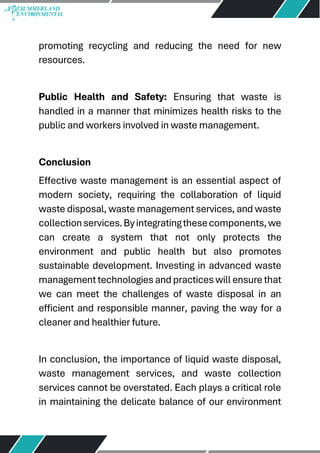What Does Reclaim Waste Mean?
Table of ContentsReclaim Waste Can Be Fun For AnyoneThe Only Guide for Reclaim WasteGetting The Reclaim Waste To WorkThings about Reclaim WasteReclaim Waste Fundamentals Explained
Domestic sewer waste refers to the waste and products from a household septic storage tank. The correct administration and disposal of domestic sewer waste need fluid waste to be transferred to a sewer therapy plant where the proper approaches and devices are applied to cleanse and dispose of waste.
Business waste often includes potential threats, such as flammable products or a mix of liquid and strong waste products, and requires an advanced and detailed disposal procedure. The disposal of commercial waste commonly entails the filtering of waste prior to transport to make sure safe and proper disposal. Industrial waste is created from by-products and overflow of industrial procedures and manufacturing.
This sort of waste can not make use of the exact same sewer management transportation or procedures as septic or business liquids. The commercial waste management process calls for the evaluation and testing of liquid waste prior to it undergoes the disposal procedure (industrial wastewater treatment). Drainage waste is the liquid waste that comes from runoff and excess stormwater in highly inhabited areas or cities
Overflow waste can create contamination and flooding if not managed effectively. Making sure correct waste management can avoid calamities and minimize environmental harm.
9 Easy Facts About Reclaim Waste Shown
Contact PROS Solutions today to find out about our waste monitoring and disposal services and the proper ways to take care of the fluid waste you create.
(https://www.goodreads.com/user/show/183557660-leon-aube)This supposed 'wastewater' is not only an important resource but, after treatment, will be released to our land, rivers or the sea. Used water from commodes, showers, bathrooms, kitchen area sinks, laundries and industrial processes is understood as wastewater.

water utilized to cool machinery or tidy plant and equipment). Stormwater, a form of wastewater, is drainage that flows from agricultural and urban locations such as roofing systems, parks, gardens, roads, courses and gutters right into stormwater drains pipes, after rainfall. Stormwater streams without treatment straight to local creeks or rivers, ultimately getting to the ocean.
The Ultimate Guide To Reclaim Waste
In Queensland, a lot of wastewater is dealt with at sewer therapy plants. Wastewater is delivered from domestic or commercial sites with a system of sewers and pump stations, understood as sewerage reticulation, to a sewage therapy plant.
The Division of Natural Resources advises local governments about handling, operating and maintaining sewerage systems and therapy plants. In unsewered locations, city governments may call for owners to set up individual or family sewage treatment systems to deal with residential wastewater from toilets, kitchen areas, restrooms and laundries. The Department of Natural Resources authorises the usage of family systems when they are proven to be effective.
A lot of stormwater gets no treatment. In some brand-new neighborhoods, treatment of some stormwater to get rid of clutter, sand and gravel has started utilizing gross toxin catches. Wastewater treatment happens in 4 phases: Eliminates solid issue. Bigger solids, such as plastics and other things incorrectly released to sewers, are removed when wastewater is passed via screens.
Wastewater then streams into large tanks where solids resolve and are removed as sludge. Grease and residue are skimmed from the surface area. Uses little living microorganisms referred to as micro-organisms to break down and eliminate staying liquified wastes and great fragments. Micro-organisms and wastes are included in the sludge. Removes nitrogen and phosphorus nutrients that can create algal blossoms in our waterways and intimidate marine life.
Reclaim Waste Things To Know Before You Get This
Nutrient elimination is not readily available at all sewage therapy plants because it needs pricey specialist tools. Clear liquid effluent produced after therapy moved here may still consist of disease-causing micro-organisms - liquid waste removal.

A lot of wastewater flows right into the sewage system. Under the Act, regional governments carry out authorizations and licences for eco relevant tasks (Ages) entailing wastewater releases that could have a regional impact.
The 10-Minute Rule for Reclaim Waste
Tracking gives valid details about water high quality and can validate that permit problems are being fulfilled. The information obtained through tracking supplies the basis for making water high quality choices.